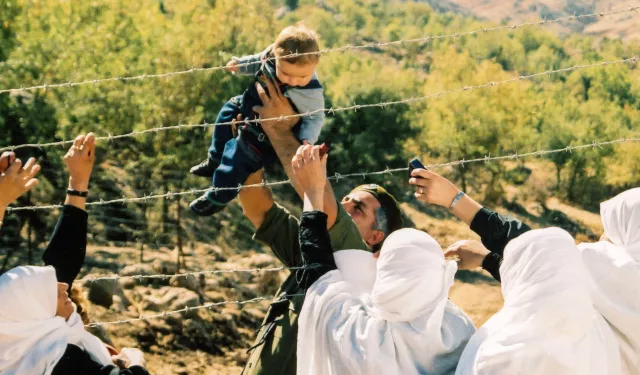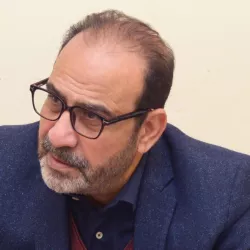
Escaping the minefield surrounding the Druze on a ‘Kite’
I first got to know of “the Druze problem” over 20 years ago at the Cairo Opera House's Small Theater during the Cairo International Film Festival, while watching “The Kite”; a bold and provocative film by the late Lebanese director Randa Chahal.
I remember it vividly—not just for its audacity and departure from the conventions of Arab cinema, but for the immediate controversy that followed its screening.
The film stirred up a storm of emotions and questions, ones that demanded time and introspection to unravel. But since reflection tends to be a skill we sideline, speculation and accusations soon prevailed among the "elite" journalists, critics, and filmmakers.
Behind the mask of love
The Kite is a tale of forbidden romance between an Arab girl and an Israeli soldier on opposite sides of a tense border. Like many “unlikely couple” stories, it wrestles with political and cultural barriers—but here, the barrier is existential: the identity crisis endured by the Druze minority split across the Syrian-Israeli divide.
Had we been more inquisitive—asked questions, sought understanding, or even simply watched more movies—we might have saved ourselves decades of bloodshed and confusion. We might have grasped the complexities of the Syrian Druze experience. That knowledge could have informed our responses to the destruction and divisions we face today—and quite possibly, those awaiting us tomorrow.
Films to stimulate the mind
Randa Chahal was an artist who dared to confront both her audience and the political systems surrounding her. During her short but impactful life (1953–2008), she created a body of work that consistently challenged censorship, political parties, institutions, and individuals.
Hailing from a leftist intellectual family, Chahal infused her films with profound political insight, particularly regarding the crisis within the Arab mind. Her documentaries tackled Lebanon’s civil war, religious extremism, and even profiled revolutionary Egyptian musician Sheikh Imam. Her most notable fiction works include “Écrans de sable” (1991), “Civilisées” (1999), and “The Kite”, which earned the Special Jury Prize at the Venice Film Festival.
In “The Kite”, Chahal explores the Druze dilemma through a fictional village on the Lebanese-Israeli border, populated by a Druze minority. The village is clearly emblematic of the Golan Heights—a place she likely refrained from naming directly, wary of Syrian retaliation during an era of a pervasive Syrian ironfist on Lebanon.
I recall during my first visit to Lebanon in the mid-1990s, I naively assumed I could speak about anything. But when I mentioned Syria casually, the people around me visibly tensed, throwing nervous glances over their shoulders as if I’d uttered Lord Voldemort’s name.
Torn across borders
The narrative follows 15-year-old Lamia as she crosses the invisible yet heavily guarded line between Syrian-controlled and Israeli-occupied Golan, dressed in a wedding gown while both sides of her family sing and cheer.
When she arrives at her new home, she tells her groom Sami that she was pressured into the marriage. Sami confesses he too had no choice, he was coerced by family obligation.
From the outset—when Druze families communicate across border fences via megaphones—the film unveils the profound cohesion among this rural minority, bound by deep traditions and a shared ethnic, religious, and cultural identity. But that unity is fractured by geopolitics. This painful truth pulses through the story.
Ordinary individuals, with limited knowledge and resources, don’t choose geography or sides in conflict. They are simply ensnared by it. Yet among minorities like the Druze, Kurds, Nubians, and Amazigh, kinship often transcends maps and nations. That discord between identity and citizenship is a defining element of the Druze experience—one that any serious policymaker must grasp.
Yes, nationality shapes identity. But so does belonging to a community that has its own language, religion, traditions, and even laws.
Recently, we saw real-life examples of “Israeli Druze” risking everything to cross the border and support their Syrian kin—caught in a brutal sectarian war. It speaks volumes about the emotional forces that drive such choices.
Walking a minefield
In the film, Lamia and Sami agree not to consummate the marriage and quietly separate. Lamia returns to her family on the Arab side.
In a parallel thread, we see an Israeli watchtower stationed near the border, often manned by a young Druze soldier. Lamia, bewildered by her surroundings, is portrayed like a child chasing after her kite, which soars through the air, oblivious to imposed borders. In one early scene, her kite lands in the no-man’s-land between the borders. She runs after it, unaware of the danger. The young soldier yells at her to stop, warning her about landmines.
Though they barely speak, a bond blossoms between them. Back with her family, Lamia begins to miss him. Her longing grows, and she dreams of seeing him again. In a pivotal scene—perhaps real, perhaps imagined—she crosses the border to reunite, only to step on a landmine and perish.
Between sectarianism and identity
Over the years, it has become clear that this tragic ending—a metaphor for a deeply political human condition that our politicians and intellectuals rarely speak of—was nothing short of brilliant.
The landmines represent issues we refuse to talk about. They are the ticking time bombs of sectarianism, the repression of minorities and those who differ, identity crises—all of which are slowly devouring the Arab world.
The Druze are not alone. Alongside them are the 1948 Palestinians, Bedouins, and others whose stories simmer beneath the surface, always at risk of eruption—as we saw in Syria, and beforehand in Lebanon, Iraq, the Gulf, and Egypt, each in different ways and to different degrees.
The film’s high artistic quality earned it the prize at Venice, despite some pompous critics who dismissed the win as merely due to its “normalization” theme!
Even now, two decades later, I still remember the gentle, expressive face of the young actress Flavia Bechara, and the music of the late Ziad Rahbani, who also appeared in the film.
To the best of my memory, Randa Chahal wasn’t at that screening. In the years that followed, sickness slowed her work and ultimately prevented her from completing a comedy she had begun developing, with a pioneering international all-female crew.
Had “The Kite”—and other bold, intellectually daring films—been more widely seen, embraced, and understood, perhaps we wouldn’t be walking the very minefield it warned us about.
